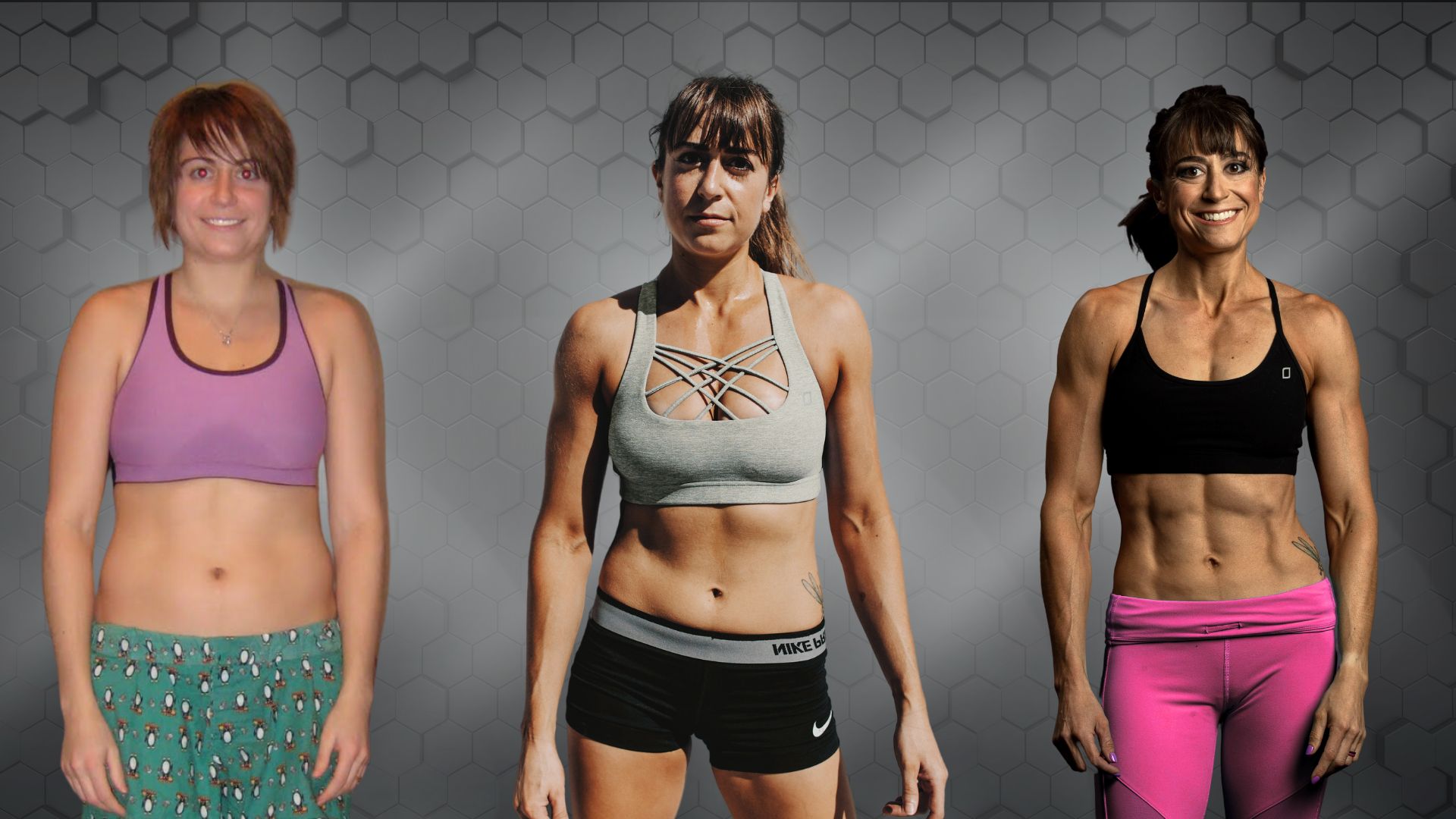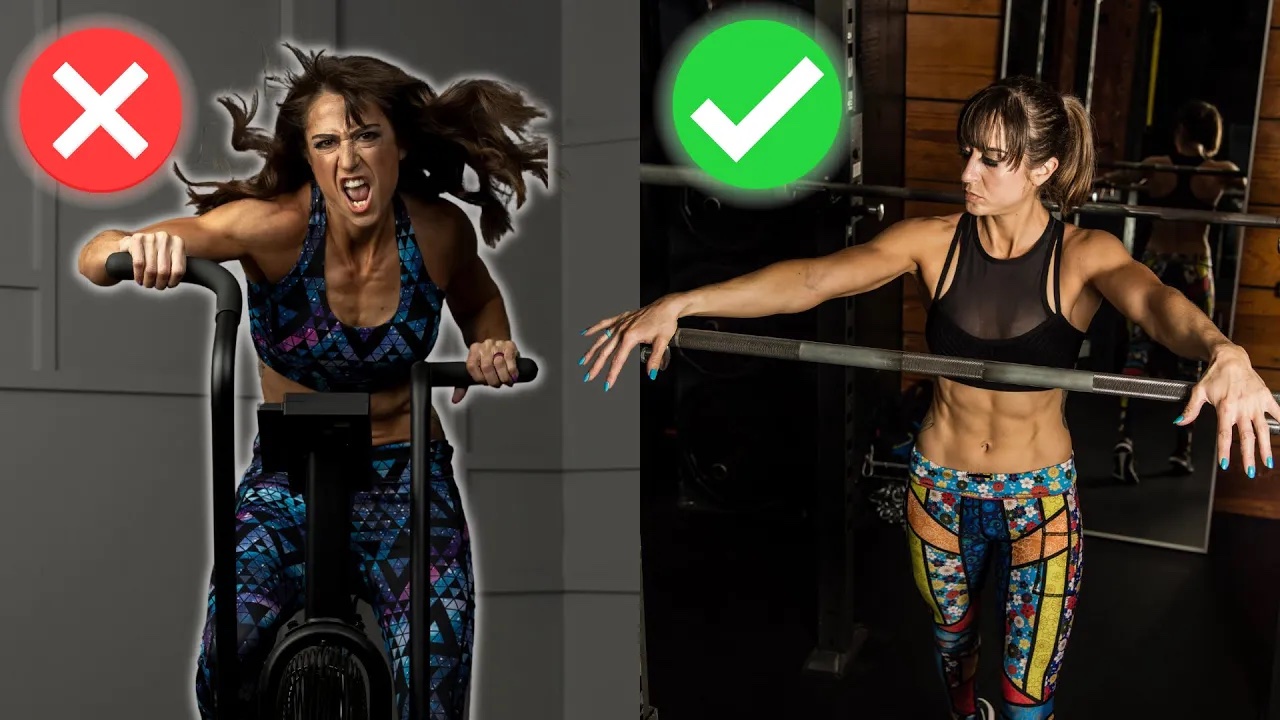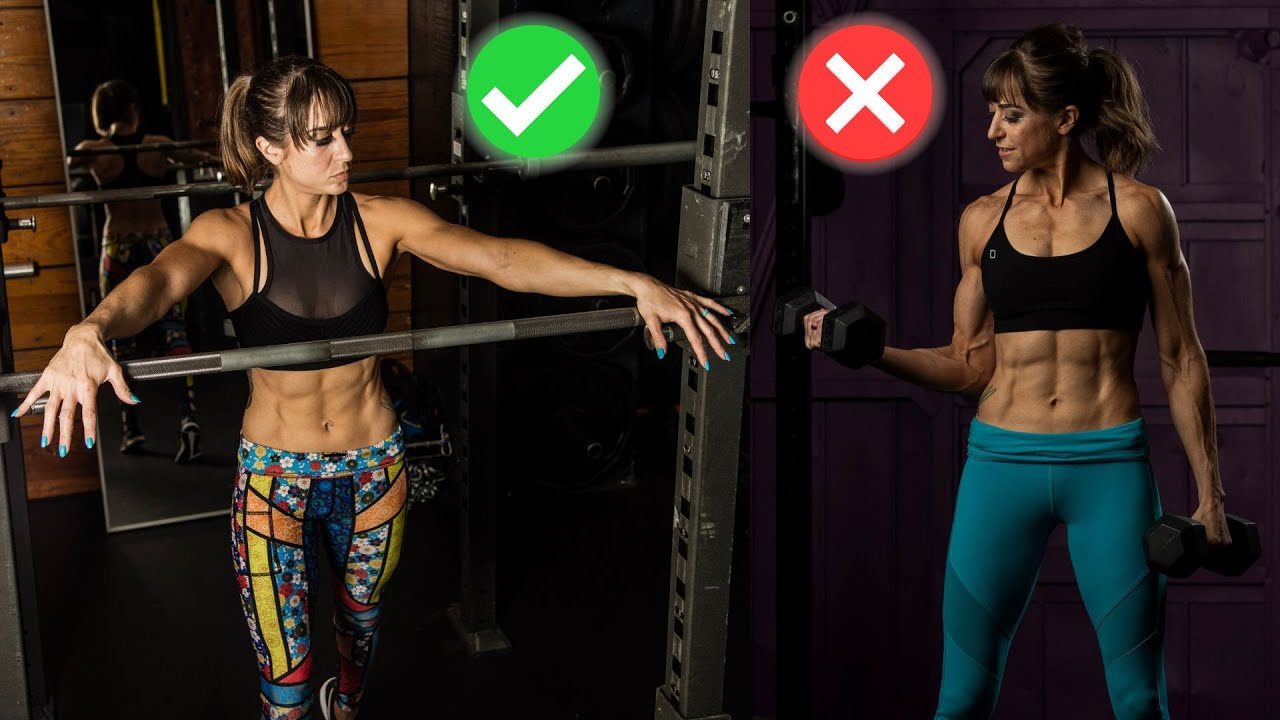
The 3 Phases Of Fat Loss (And How to DO IT RIGHT!)
To lose fat you don’t just do one thing the whole time. There are phases and cycles.
Your diet and your workouts should EVOLVE.
That’s why I want to go over 3 different phases you can cycle through during your fat loss journey to see amazing results that LAST and know you’re progressing over time.
Because we have to trust the process…but that is easier said than done.
Not to mention our body needs and goals evolve over time and we have to meet them where they are at, which means at times what was working may not work based on what we need right now and we need to adjust.
That’s also why these 3 phases aren’t just a step 1, 2, 3 kind of thing.
You may go in and out of these phases based on YOUR progress and even desire for faster results at times over more of a lifestyle balance.
And you may return to even phase 2 at points as you even maintain your new lean, strong look!
So the 3 phases I’m going to go over are….
The Lifestyle Build
The Mini Cut
The Diet Break

Let’s start with the main Fat Loss Phase where you’ll find you spend most of your time…what I call the Lifestyle Build.
I just want to be clear about one thing…
What you do to reach your fat loss goal is not what you will do to MAINTAIN your results.
There is a transition to maintenance which I’ll go over more with Diet Breaks.
But you DO want to be creating sustainable habit changes as you lose fat because you can’t just do one thing to lose then go back to what you were doing prior.
And so often our desire to lose faster leads us to doing practices that also ultimately backfire in metabolic adaptations and mental burnout.
This is so often why we end up just losing weight to regain it and even more right after.
That’s why I recommend you most often START with this phase and spend most of your time in the Lifestyle Build.
With this phase, you’re slowly tweaking your nutrition and workouts in a way that truly meets you where they are at in a way that is based off of 1% improvements.
You’ll often track your current diet and workouts first.
You’ll focus on what feels like a realistic schedule to train based on what you easily can do right now.
You’ll take a hard look at your current habits and truly OWN what you’re doing now to adjust.
Then select a small change that feels like it is so silly simple you could do it on the worst of worst days even.
Too often we base changes off what we can do when life is perfect.
But because life often is NOT perfect, we create habits we can’t maintain over ones that we can get disciplined with quickly because they are just only slightly pushing our comfort zone over completely outside it.
This then builds momentum to do MORE and see results snowball faster and faster.
But it helps us ease in over overwhelming ourselves with habits we’re willpowering our way through.
Because too often we do so much we overload ourselves and mentally rebel.
We feel restricted. We feel like nothing will work for us because it’s too much.
The excuses pop up because we have other priorities fighting the changes.
In this phase, you’ll want to start even with a minimalist macros approach and a very small calorie deficit.
Once you see what calories you’re maintaining, or gaining weight with by tracking your current diet, you will cut out 100-200 calories and focus on nutrition by addition and adding protein.
You want to work to get your protein to 30-35% of your calorie intake to start.
This focus only on calories and protein simplifies with a clear focus.
It also helps us find our balance including foods we love while also fueling our body in the way it needs.
It’s about true changes to our lifestyle over forcing ourselves into a mold and demonizing foods.
From here you may begin to cycle macros and even adjust carbs and fat.
You want to adjust macros over cutting calories further, using those changes in energy source and even higher protein, up to 40%, to help you continue to see fat loss happen.
However, if you find your current calorie intake, while you aren’t losing and even gaining, is 1200 or below, you may want to start with phase 3, a diet break first!
And with these diet changes, you will also focus your workouts on a balance of strength and cardio.
We can’t out exercise our diet, but both need to work together to help us lose fat while not losing muscle and avoid metabolic adaptations.
Cardio especially with this deficit may be more focused on sprint intervals and walking while we focus on still lifting heavy.
We don’t want to turn to cardio only!
During this phase, you will also want to continue to push and challenge yourself with weights in the gym. Doing everything you can to build muscle while in a small deficit will help you better maintain your results.
Workouts may be slightly more metabolic strength though with things like circuits or even some interval strength training.
Now how can you know things are going well…
I will tell you the scale is NOT necessarily going to be your friend.
Because you’re after fat loss, not just weight loss. And slow progress on the scale doesn’t mean you aren’t losing fat – it means you’re not losing muscle too and creating unsustainable changes.
So often when we start our fat loss journey, we do so much we deplete our body completely, leading to fast scale results, only to see every little deviation from our diet or workouts lead to massive gains.
And of course, we regain the weight…which is what has brought you to this video to finally see the fat loss results you deserve.
So with seeing true fat loss results you can expect to see these signs during the Lifestyle Build…
#1: You will see inches being lost while the scale will be SLOW to change.
#2: You may lose up to 1lbs per week but no more.
#3: Your energy can dip then level off as you adjust to changes in your macros and that initial little deficit. Your calorie deficit will be small so you shouldn’t be starving if you do this right! You may even feel FULLER with the change in macros!
#4: Workout numbers should still consistently improve.
But you shouldn’t see massive swings in how you feel or like you’re starving. So often we try to lose fat, end up hangry and just then binge on whatever we can find when we can’t stand the restriction any longer.
That won’t happen if you do this right because you’re creating that very small calorie deficit!
Just note…tracking is key! And one day off plan, the “I was good all week” to fall off on the weekends, can have a massive impact because you’re creating that smaller calorie deficit over the week.
So be aware of those patterns to make small adjustments!
But also note, results are consistent but fat loss isn’t something that’s going to happen overnight.
If you do know that you need that initial bigger change to stay motivated, while you will spend most of your journey in this phase to prevent metabolic adaptations especially through a higher calorie intake and balanced training, you may start with phase 2…
The Mini Cut.
The Mini Cut is an intensive fat loss protocol…
And not fun.
It is more restrictive, going to be tougher macros and a bigger calorie deficit.
It is a kickstart or plateau buster.
It is a short term, quick fat loss sprint to be used strategically.
While I prefer to start with the Lifestyle Build to ease in to change and create more motivation to do more, sometimes we need that extra little push to see results happen then dial things back to embrace the process.
We need the motivation of that quicker result to help us want to keep going.
That’s where Mini Cuts come in.
Generally done for 7-14 days, these kickstarts will put you in a 500 calorie deficit off what you’re maintaining your weight at.
They will also mean tracking EVERYTHING PRECISELY and adjusting your protein, carb and fat with a full macro breakdown.
They are not fun ratios either. Your protein is going to be 40% at minimum and often up to 45-50%.
Your fat and carbs will often be in that 20-30% range.
And food quality matters. This isn’t the time to work in foods you love. Or to include your alcohol or lifestyle balance.
This is a CUT.
Your energy may take a hit.
This won’t be the time to focus on performance goals.
Mentally this will be harder. BUT you know it is short term.
And unlike fad diets, this is still based off the fundamentals of macros and a training progression and you have an EXIT STRATEGY.
Your workouts should also shift away from cardio during this time aside from walking.
The big deficit puts you at risk for losing muscle, which is why protein goes up and intensive cardio goes down.
Workouts should be very focused on strength!
And rest between rounds will be key. Don’t cut it out.
Then after your Mini Cut 7-14 days, you will slowly increase calories over the weeks, 100-200 at a time to get back to either your maintenance or small Lifestyle Build calorie deficit as you drop your macros back to something more sustainable.
Mini Cuts are a great way too as you reach your fat loss goals to maintain the level of leanness you want year around.
Because even as you maintain, you can throw one in if you’re going to travel or have been a little lax around the holidays.
They can be that push for balance with the ebb and flow of life.
If you do a Mini Cut…some signs you’re doing it right…
#1: The scale may change up to 5 pounds during this quick protocol.
#2: Bloat will go down fast.
#3: Energy may dip.
#4: Workout numbers may not improve.
#5: Some hanger and cravings may pop up but remember it is a short sprint!
While Mini Cuts can be satisfying in the faster progress you see on the scale, doing MORE of them will backfire and not lead to faster fat loss and even potentially metabolic adaptations where you see weight creep on as you eat less and less.
So be conscious not to extend them out past 21 days and to slowly increase out of them.
And do not do them if you’re currently eating 1200 calories or in a big deficit already.
If you are in a deficit already of 100-200 calories, consider cutting no more than 300 off and even consider a Diet Break before or after!
Which brings me to Phase 3…Diet Breaks.
Sometimes the best thing we can do is do less to achieve more.
Slow down to speed up.
Sometimes our body, and mind needs a break!
This is where Diet Breaks can be key.
After an extended time in a deficit, our body adjusts.
And too often we cut calories lower when this happens. But then we adjust again. And unless we end up eating nothing, we can’t keep cutting calories lower and lower.
Not to mention if we cut calories too low, our body will actually find ways to reduce our energy expenditure to match which is why we can stop losing and even start gaining as we eat less and less.
This is why I recommend cycling macros.
But if you’re finding that isn’t kickstarting progress and you’ve been in a deficit for 3-6 months, consider a Diet Break.
Especially before or after a Mini Cut.
A Diet Break is like a mini maintenance period.
You’re focus is on maintaining your current results while eating more and training harder.
It is not only a break for your body, but even mind.
Because while you’re trying to create sustainable changes in the Lifestyle Build, you’re still in a deficit.
You’re still pushing to lose and tracking and often doing workouts when you’d sometimes like to be lazy.
Achieving results is hard.
So sometimes we need the break to care less, even if just because life priorities have shifted so we’re feeling burned out.
But during this phase, you want to slowly try to bump calories up even by 200-500 from where you are. This may be done all at once, or you may do it slowly over a few weeks.
A diet break will range from 7-21 days.
You will often also return to the minimalist macros approach, working in foods you love and focusing even just on protein hitting 30% of your calories.
You want to work in foods you maybe haven’t.
You want to also cycle carbs and fats up if one has been lower.
And in your workouts, you want to combine strength and cardio, even using some steady state cardio especially if you enjoy it.
You want to focus on pushing in your workouts and you should really set performance goals during this time.
You’ll know you’re doing a diet break right because you’ll…
#1: See your energy increase and feel extra fueled.
#2: Feel like performance goes up and you’re lifting heavier and setting PRs.
#3: You may feel bloated to start as you increase those calories especially if you choose to do it in one go.
#4: You will first see the scale jump but even by the end see your measurements go down.
#5: You may see the scale fluctuate LESS daily.
Your body won’t be depleted of anything in this phase, that’s why you may see a jump in the scale to start especially the quicker you up calories.
But this will level off. And you may end up losing, but don’t be surprised if you do stay up in weight just slightly.
Take measurements during this phase as you may be surprised to see inches come off even while on a break. Gaining muscle as you lose fat during this phase often happens.
This is a great little muscle gaining phase even to help with avoiding metabolic adaptations and even help you LOOK LEANER as you lose.
Just eating at this level of maintenance or slight surplus can be the muscle boost you need and help you learn what maintenance will even look like for you after!
But embrace the balance to get remotivated and kickstart things when you go back to that Lifestyle Build even.
And if you’re thinking, “But I’m so far from my goals!”
We still will often need a diet break and even all the more because we will need longer deficits.
This also recharges us to keep moving forward!
Remember these phases aren’t steps to do in one order, but phases you will cycle through even many times over your fat loss journey.
Where are you on your fat loss journey? Which phase are you in or will you be moving to next?
Want guidance and support to navigate these phases and see the LASTING fat loss results and muscle definition that you want?
Learn more about my Private Online Coaching!




